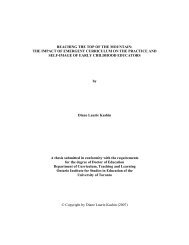The Reading Chair
Create successful ePaper yourself
Turn your PDF publications into a flip-book with our unique Google optimized e-Paper software.
Books<br />
More books about mathematics<br />
Big Fat Hen, by Keith Baker.<br />
Big Red Barn, by Margaret Wise Brown; illus. by Felicia Bond.<br />
<strong>The</strong> Doorbell Rang, by Pat Hutchins.<br />
Five Creatures, by Emily Jenkins; illus. by Tomek Bogacki.<br />
Let’s Count, by Tana Hoban.<br />
One Duck Stuck, by Phyllis Root; illus. by Jane Chapman.<br />
One Grain of Rice: A Mathematical Folktale, by Demi.<br />
Dramatic play<br />
Using dramatic play to act out fantasies gives children a way to determine<br />
their needs and work out their fears. Children find security in acting<br />
out daily routines; activities, such as caring for babies (with a doll and<br />
bottle) or baking (with frying pan and cookbook), can also encourage<br />
social-emotional development and teamwork. In addition to acting out the<br />
familiar, children love to dramatize traditional tales—especially with costumes<br />
and props. Such tales deal with everyday emotional hurdles: bullying<br />
(Anansi), separation (Goldilocks), or fear of a powerful animal (<strong>The</strong><br />
Story of Little Babaji). Through imaginative play, a child can experiment<br />
with being the boss, being nurturing, or being part of a team.<br />
Good Thing You’re Not an Octopus<br />
Written by Julie Markes. Illustrated by Maggie Smith.<br />
While routines are important to them, young children can sometimes be<br />
less than cooperative. This book is a humorous take on children’s resistance<br />
to certain parts of their day. “You don’t like to get dressed in the morning? It’s<br />
a good thing you’re not an octopus. If you were an octopus, you would have<br />
eight legs to put in your pants!” From the shark that has to brush 200 teeth<br />
to the bear whose nap lasts all winter, children will laugh at the fact that they<br />
don’t have it so bad after all.<br />
After reading this book to children, teachers can<br />
• stock the dramatic play area with reading materials that go along with<br />
play themes (e.g., magazines for patients waiting for the doctor); dressup<br />
clothes for boys and girls; blankets to cover sleepy babies; dishes,<br />
silverware, and pots and pans for cooking and eating favorite foods.<br />
• make or purchase animal puppets that children can use to act out the routines<br />
in Good Thing You’re Not an Octopus. Offer additional animal puppets that<br />
don’t appear in the book to encourage children to make up new parts to the<br />
story.<br />
More books about routines at home and school<br />
Bee-bim Bop! by Linda Sue Park; illus. by Ho Baek Lee.<br />
Bread Comes to Life, by George Levenson; illus. by Schmuel Thaler.<br />
I Eat Fruit, by Hannah Tofts.<br />
Miss Polly Has a Dolly, by Pamela Duncan Edwards; iIllus. by Elicia Castaldi.<br />
Beyond the Journal • Young Children on the Web • May 2007


















